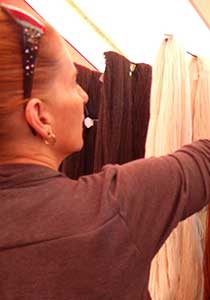One of the things I really like about knitting is that there is next to never, only one way of performing a technique. Take short rows for example, ask several different knitters and you will find several different ways of adding fabric to your work without adding overall length. (Particularly useful if you want to add more ease in the front of a pullover or are working fitted sleeves, top down having picked up sts around the armhole.) Today we will look at Japanese Short Rows and the Catch Method.
Materials
Two hands
Some Knitting
Removable Stitch Markers for Japanese
Short Rows: The Japanese Method
Step 1 (RS): Work in pattern to the st specified in your pattern (for my swatch I worked to 5 sts from the end).
Step 2: Turn your work.
Step 3: Place a removable stitch marker on your working yarn before working the next st.
Keep performing Steps 1 – 3 until you have completed your short row section.
Closing the Gap
Step 1: Work to the st before the turning yarn marker and sl that st. (Shown on wrong side so marker is visible.)
Step 2: Pull up on the marker and place the yarn on the LH needle, remove marker, replace turning st on LH needle and work together with the turning yarn. (SSK on RS, P2tog on WS)
Repeat Steps 1-2 until all gaps have been closed.
Short Rows: The Catch Method
This method starts the same way as the Japanese method of creating short rows (above), but does not use a marker.
Step 1: Work up to and including your turning stitch. Turn your work.
If a knit side is facing you, slip the turning stitch with the yarn in the back of your work.
If a purl side is facing you, slip the turning stitch with the yarn in front of your work.
Closing the Gap
Work to turning stitch,
pick up the strand of yarn below the slipped stitch (like a lifted increase)
and work it together with the turning stitch.
Other Short Rows Tutorials
This tutorial is part of our Short Rows series – see our tutorials on German Short Rows and Wrap and Turn as well.
 ABOUT THE INSTRUCTOR: MARY E. ROSE
ABOUT THE INSTRUCTOR: MARY E. ROSE
Mary has been knitting for over 40 years.During this time she has discovered that she hasn’t met a knitting technique she didn’t like. As a fearless knitter, she will occasionally call her children over to “see something scary” such as pulling the needles out of a 400 stitch lace shawl, ripping back ten rows and picking the stitches back up, without a lifeline. (But, she does suggest using them, so don’t try that at home.) She believes that things are always easier the second time, so she gets the first time out of the way as quickly as possible, and that with a little practice, you can master any technique.
She currently lives in Central Ohio with her three children, who also craft. She can be found on Ravelry and her blog, or with knitting needles in hand, guarding her stash, whilst knitting a swatch.













Leave a Reply